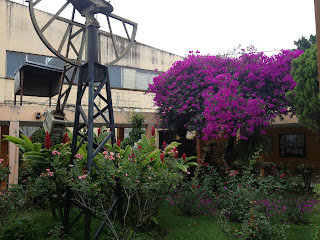Of course one great thing about INPUT is that it is truly international, and most delegates try to squeeze in a little travel before or after the conference. I was able to tack on a couple of days at the end and see a bit of the country. Here are a few photos:
There is a memorial to the victims of the civil war on a wall in a park in downtown San Salvador, which I visited with Bill Gilcher of the Goethe Institute. A bas-relief frieze includes a woman holding a picture of Oscar Romero, and more than 30,000 victims' names are carved into the stone. The inscription in the picture on the right acknowledges that the names of thousands more victims will never be known.

But life goes on and the outdoor street market in San Salvador is a wildly eclectic, high-energy scene every day except Sunday. For about a dollar you can buy a cartoon-figure pinata - or just about anything else! And all the women wear a handy little apron with lots of pockets called a delantal.



On my last day in I took a tour of the western part of the country called "La Ruta de las Flores" - the flower route - with fellow INPUT delegates Eren McGinnis of the U.S. and Lefty Fylaktos of Greece. We visited 3 small villages, one of which, Izalco, was the center of the 1932 massacre in which some 40,000 indigenous people were slaughtered by the government for participating in an uprising led by communist guerrillas Farabundo Marti, Alfonso Luna and Mario Zapata. The leaders were executed as well, as seen in the article in this photo. During the civil war of 1980 - 1992 the coalition of guerrilla groups that led the fight against the government was called the Farabundo Marti National Liberation Front (FMLN). Today the FMLN is one of 2 major political parties in El Salvador.
The tour was so full of history and things to eat and see that it seemed to last much longer than a day. Here are a few more pictures. The mural is in the little village of Concepcion de Ataco which has a lot of beautiful wall paintings.
  |
Making pupusas, the delicious national dish |
 |
| Iguana-shaped bread |
 |
| A coffee mill in Ataco |
 |
A stack of beaded bags |




















